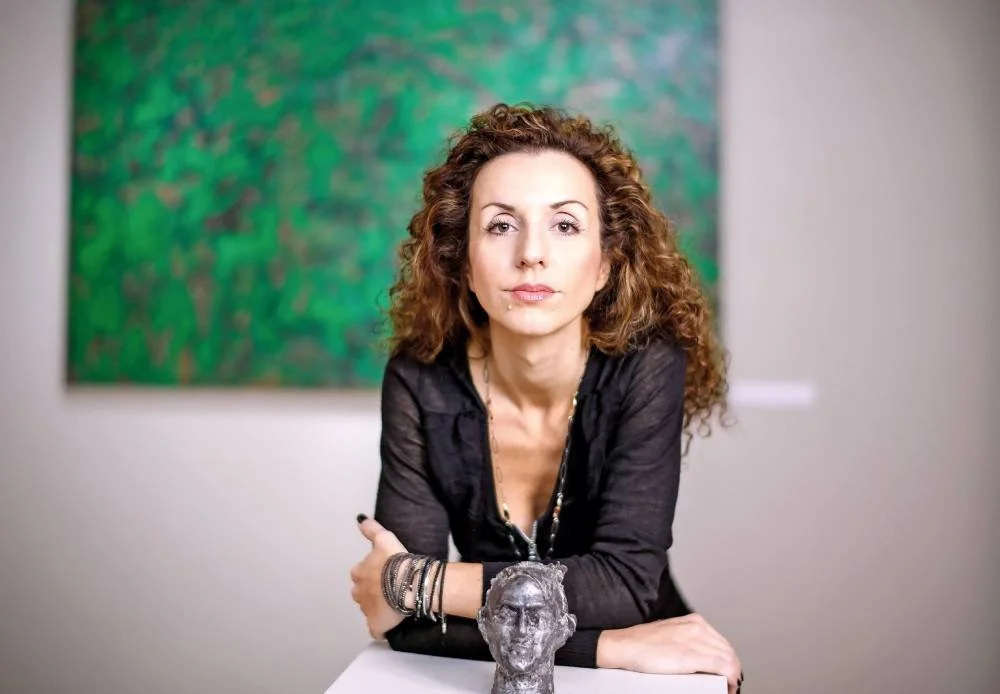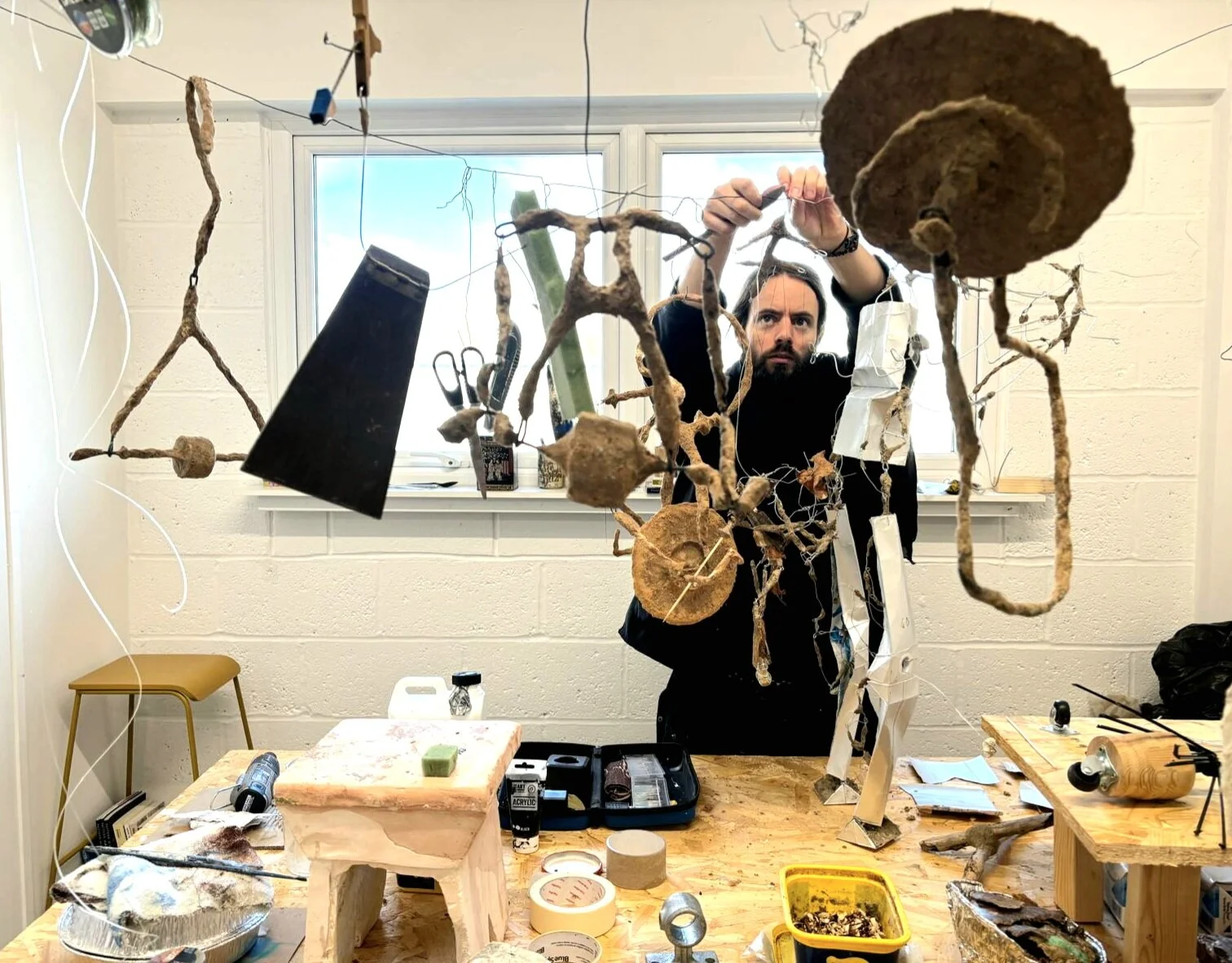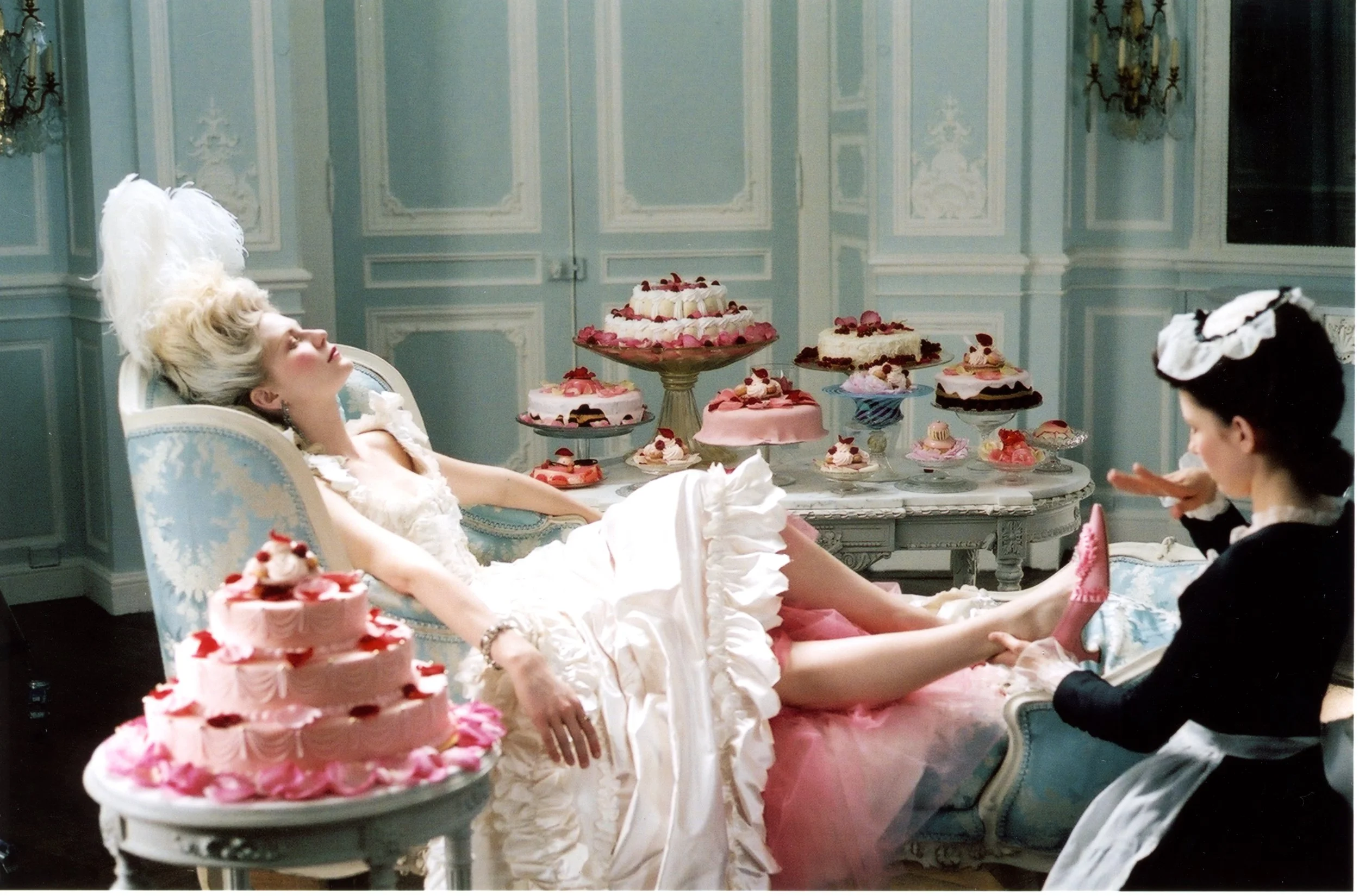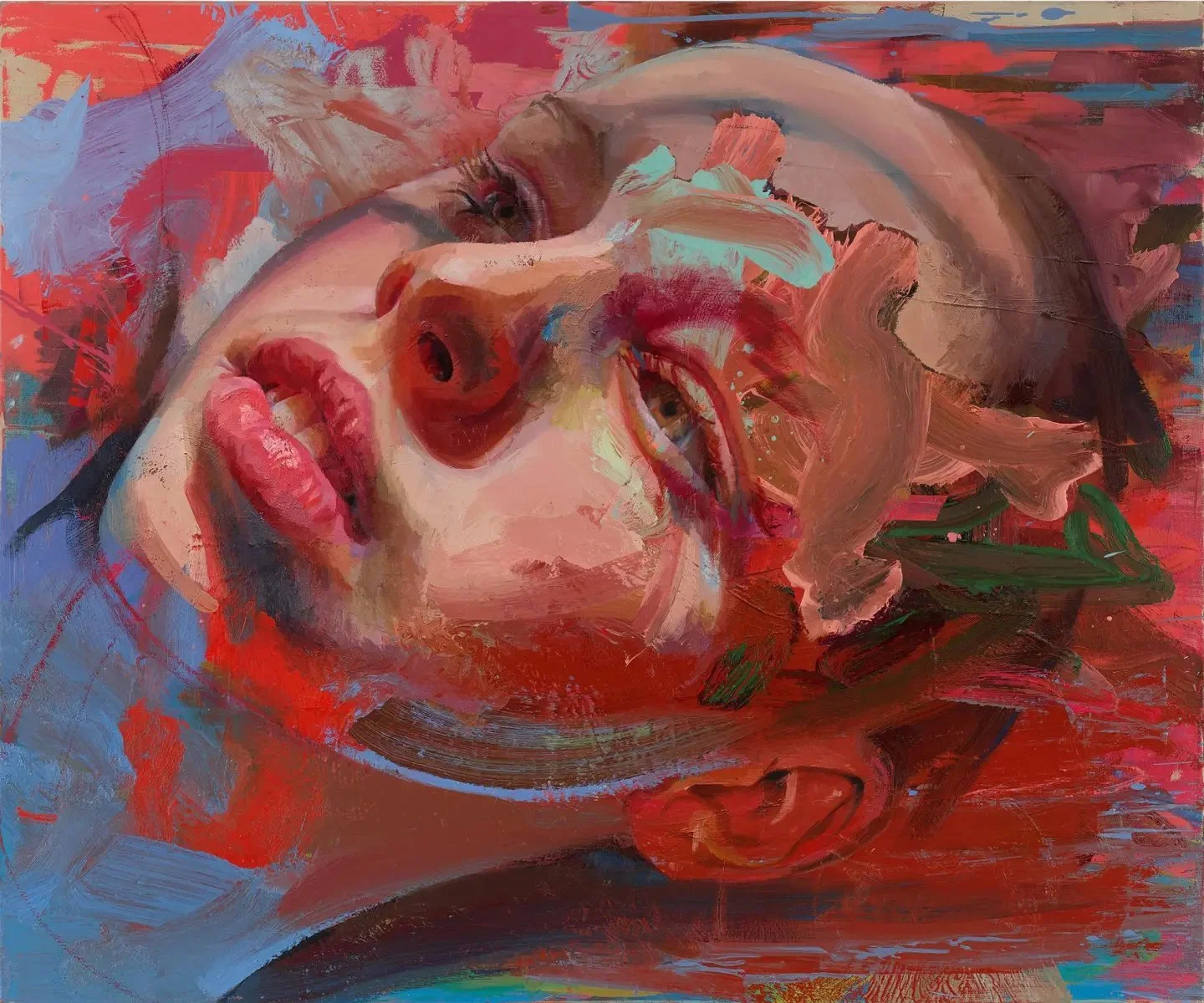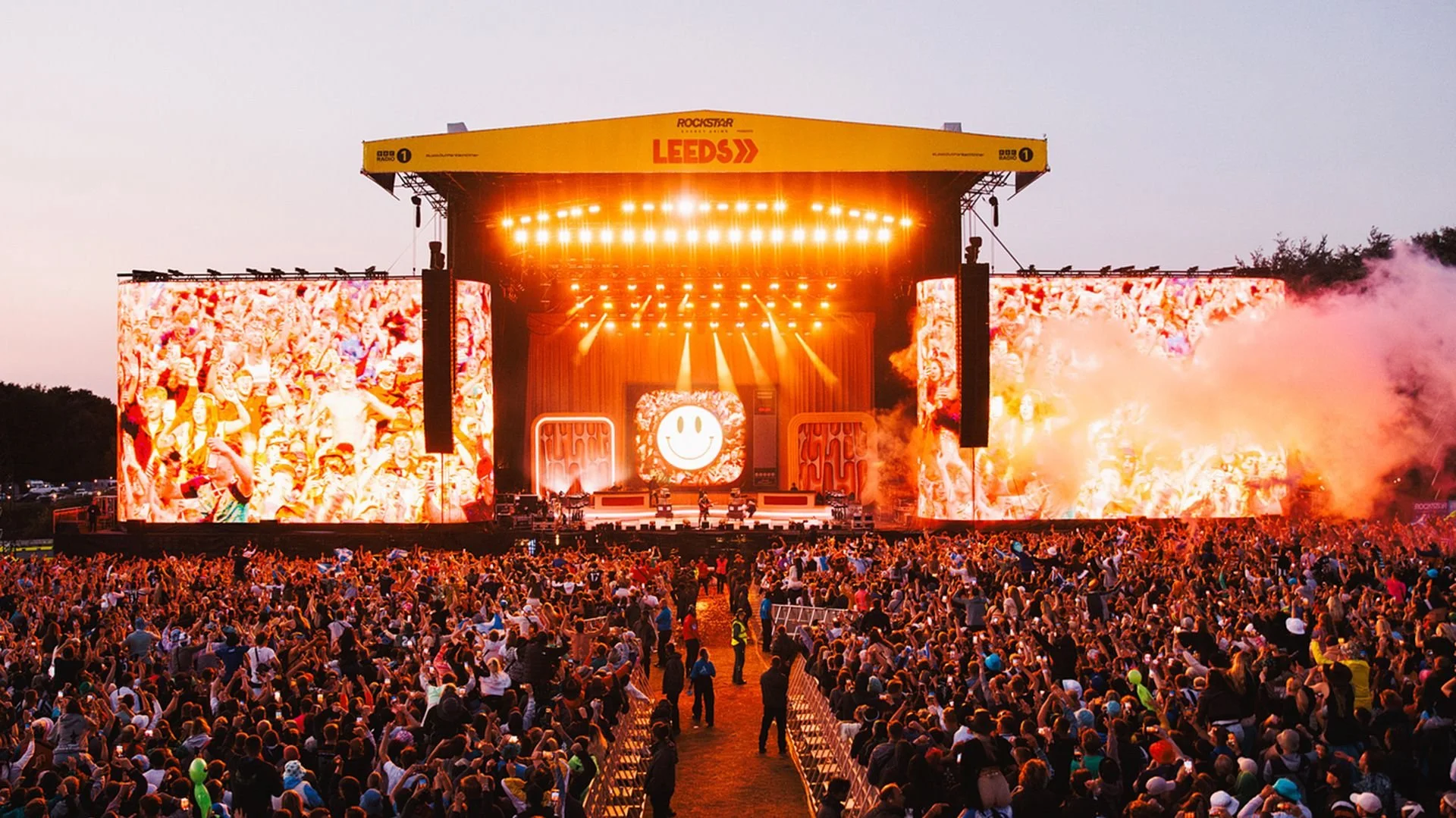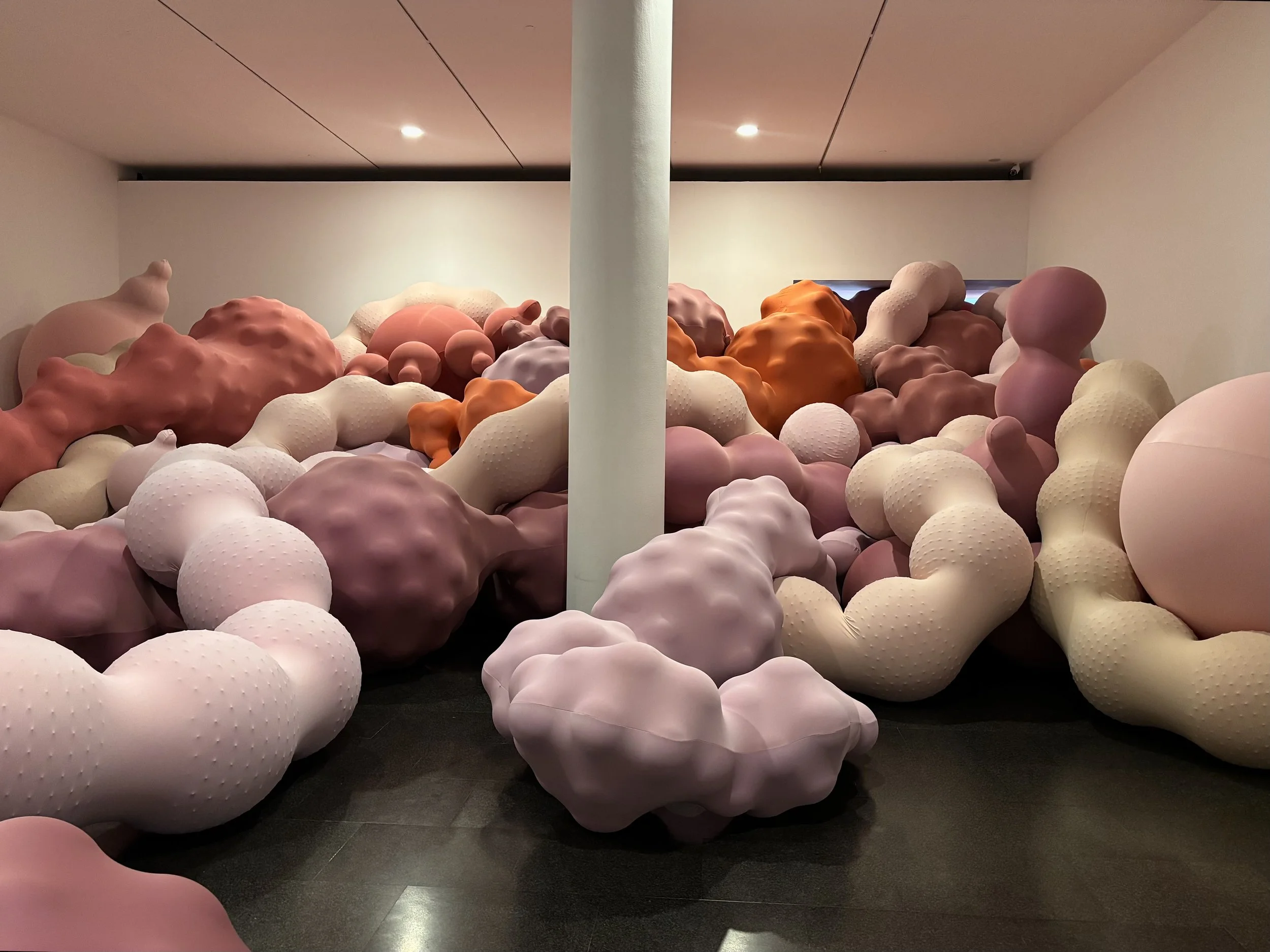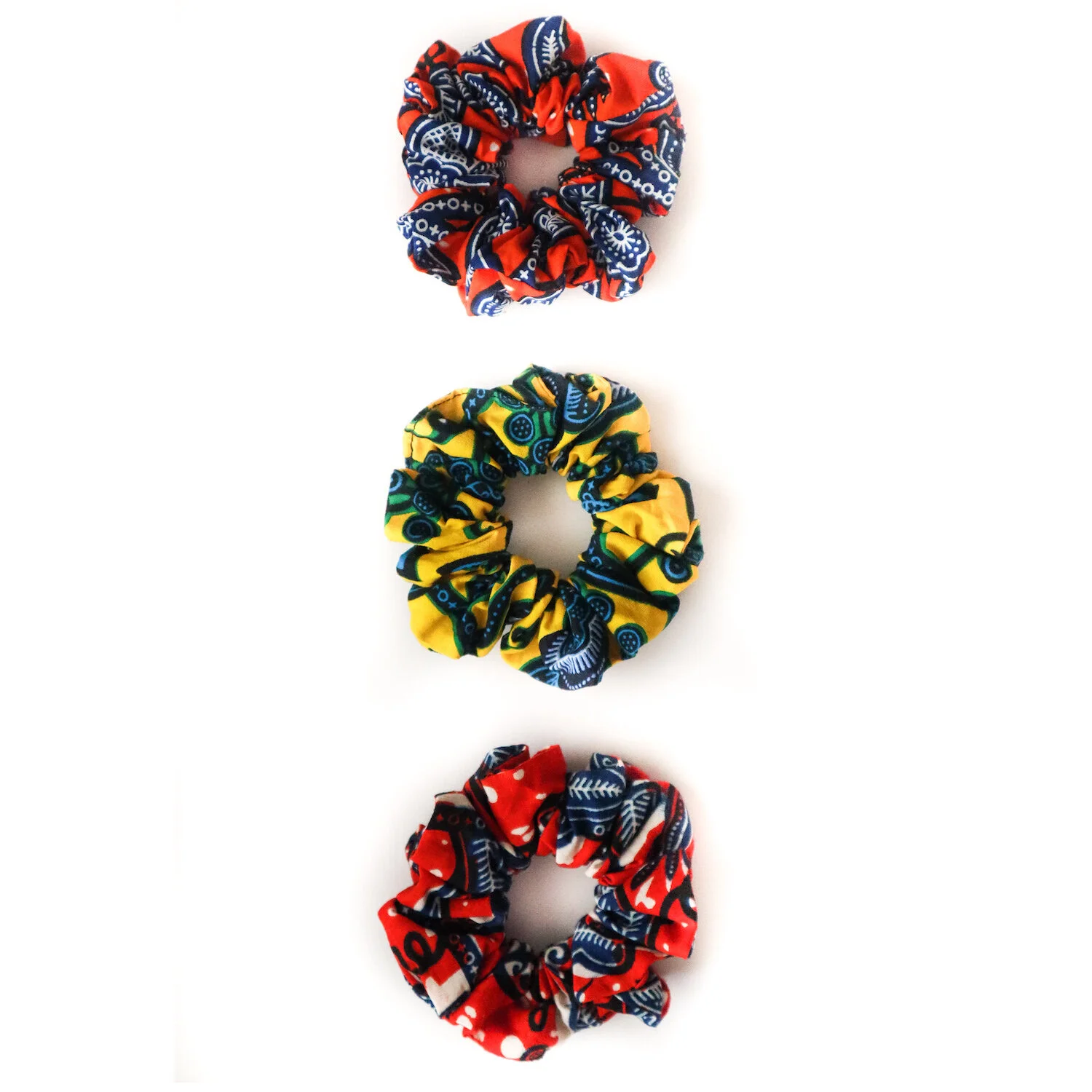In conversation with Claire Luxton
“I’ve always been passionate about public art and the importance of free art installations. I vividly remember seeing a lot of free art as a child...”
- Claire Luxton

Claire Luxton. Field of Dreams 2024 by MTArt Artist Claire Luxton commissioned by Battersea Power Station. Photo by Backdrop Productions.
Claire Luxton is a British contemporary multi-disciplinary artist working with photography, immersive installation and poetry.
Her latest work, Field of Dreams, is part of a partnership with Battersea Power Station to bring a free-to-view, botanical inspired art installation to the iconic London landmark. Suspended from the ceiling of the Power Station’s Turbine Hall A, Field of Dreams is a towering 12 metre structure made up of 33 layers of intricately printed fabric designed to explore the intrinsic connection between nature, mental health and self-awareness.
We sat down with Claire to find out more about her latest installation and how she brings together elements of the natural and the urban world in her work.
Tell me about Field of Dreams. What was the creative process?
When I started working on Field of Dreams, I knew I wanted to create an immersive installation. I’m a multidisciplinary artist and for site specific locations I always start with a lot of research, especially when it’s somewhere with such a rich history. Field of Dreams is a very layered piece, both literally and metaphorically, with lots of different elements and moving pieces. The soundscape is influenced by all the natural sounds from my studio in the countryside that I could hear whilst I was working.
A lot of it comes together simultaneously. I also write poetry when I’m creating art, and this project was a great example of each element informing the other. The whole process took around three to four months.
How did Battersea Power Station influence this process?
It’s such a huge space, and this is something I was very conscious of when developing the different sensory elements. For the suspended piece in Turbine Hall A, I started off making maquettes in my studio to try and show what was in my brain and how it would be scaled up. It started as sculpture, then became digitised, and was eventually turned back into a sculpture for the installation.
It was also important to me to bring some of the surrounding architecture into the work. When you look at the installation dead on there’s some disruption and breakup, but the spacing is the same as the Power Station columns. Although the fabric is delicate, in such an industrial space, it seems to hold its own weight.
I had the opportunity to work with the florist Moyses Stephens, who run a shop and floristry school next to the Power Station. I worked with them on what botanicals I would need, which were then brought to my studio so I could integrate them into the work. I placed the botanicals on massive sheets of glass and photographed them from high above to create images which were transposed onto the fabric. I worked in the same way for the digital videos, building the set and designs in my studio.
I also designed the soundscape to change depending on which floor you’re on. The Power Station is on three levels, and the work traverses all three, so it encourages people to go on a journey and explore. By the time you reach the top floor you hear birds and rainfall, like you’ve moved upwards with the art. There are a lot of different elements like this throughout the Power Station that bring the whole experience together.

Field of Dreams 2024 by MTArt Artist Claire Luxton commissioned by Battersea Power Station. Photo by Backdrop Productions.
What was the installation process like?
It takes a lot of time and a lot of people to make physical artwork of this size, and with the scale we were working at it was so important to make sure everyone was aligned. There has to be level of trust with the team that they can see the vision and understand how to implement it.
I had panels suspended in my studio which is a fairly large space, but nothing like the size of the Power Station! It’s actually a bit of a nerve-wracking experience as there’s only so much you can do before the day of installation, but that also makes it more exciting. I had a videographer following me during the installation and I’ve shared the process on my Instagram page, which shows the number of people involved. I was lucky to have such a great team supporting me.
You’ve created quite a few public works of art, including in iconic urban locations Leicester Square, Wembley Park and Marble Arch. How do you balance the natural world, which is such a strong theme in your work, with these urban surroundings?
I’ve always been passionate about public art and the importance of free art installations. I vividly remember seeing a lot of free art as a child, and it’s something that’s really stuck with me as I’ve developed my own work over the years. A lot of people feel that art isn’t accessible and there are often a lot of visual biases. I hope that with these sorts of installations I’m helping to democratise art. I want people to stumble upon it during their day in a way that’s pleasantly disruptive and starts conversations.
Nature in industrial spaces can be transformative, and this is something that’s always been at the heart of my practice. I make my works immersive to give people pause and allow them to experience something they might not usually. It’s been shown that just spending time in a natural or nature-enriched environment can change your brain structure. The colour green also sends relaxation signals to our brain so this was something I wanted to incorporate. I try to take all of the valuable elements I have access to working in the countryside and use them in urban spaces.
What do you hope viewers take away from Field of Dreams?
The very first time I went to Battersea Power Station was a year before Field of Dreams. I didn’t even know about the project at that point. It’s a beautiful space but very industrial, with a lot of brick, steel and concrete and not much natural light. I was standing in Turbine Hall B, and I glanced up and saw a tiny window, and through that there were big green palm leaves. This really resonated with me and remained a prominent visual.
I wanted to create my own vista, with windows and panels for people to look out into. I want to make people more aware of our pace of life, how this impacts mental health and our relationship with the natural world. There’s a juxtaposition between the natural and digital worlds, but I try to make them work in symbiosis and with better harmony. I find it interesting to use a combination of traditional and digital artistic techniques, and I hope this prompts reflection amongst people experiencing the art.

Field of Dreams 2024 by MTArt Artist Claire Luxton commissioned by Battersea Power Station. Photo by Backdrop Productions.
What else are you working on at the moment, and what should we look out for from your studio?
I’m working on a whole new personal collection of portraits. When I was first studying, my work was primarily sculpture, but over time it’s evolved into photography. Initially I felt like I had to specialise in one area, but once I leaned into multi-disciplinary work is when things started to flow. I’m also in the very early stages of a poetry book which I’m really excited about as that’s something I’ve wanted to share for a while.
I love working in London and doing projects in such iconic locations. I’m always so inspired by the opportunity to tell a story through the space. My dream would be to work with the Tate Modern, but we’ll see!
Claire Luxton’s Field of Dreams is at Battersea Power Station from 29 April – 16 June 2024. Find out more about the work here, and about Claire here.
Interview by Ellen Hodgetts
Oskar Zięta is an architect, process designer and artist whose work challenges the boundaries between disciplines. His practice brings together design, engineering, art and bionics to create sculptural forms. His latest installation, ‘Whispers’, is currently on display outside One New Ludgate as part of the London Festival of Architecture 2025…
Danny Larsen is a Norwegian artist who has transitioned from a successful career in professional snowboarding to establishing himself as a distinctive painter. His detailed neo-pointillist landscapes reflect a deep connection to nature and a personal journey of transformation. Ahead of his debut London solo exhibition…
Lindokuhle Sobekwa is a South African photographer from Katlehong, Johannesburg. Since his first exhibition in 2013, his work on social issues and personal histories—like his photo essay Nyaope—has gained international recognition. A member of Magnum Photos, Sobekwa was recently awarded the 2025 Deutsche Börse Photography Foundation Prize for his project I carry Her Photo with Me…
Sol Bailey Barker is a multidisciplinary artist whose work explores the connections between ecology, mythology, and speculative futures. Through sculpture, sound, and installations, they blend ancient knowledge with emerging technologies to examine humanity’s relationship with the natural world…
Nimrod Vardi and Claudel Goy, directors of arebyte Gallery, discuss how the space is redefining digital art by blending technology, social science, and immersive experiences. From AI and consciousness to the societal impact of tech, arebyte’s bold exhibitions go beyond visual spectacle, focusing on meaningful engagement and innovative presentation…
Hanna Salomonsson is a London based Swedish ceramic artist. Following a career in landscape architecture, she re-trained in ceramics in 2018. She also holds a BA in Art History, and this combined with her landscape grounding provides a unique vantage point for her ceramic practice…
Varvara Roza is a London-based private art advisor and artist representative. She specialises in promoting contemporary art by both established and emerging international artists. In our conversation, we discussed her unique approach to the art market…
Daniel is a curator-producer dedicated to the social impact of the arts and cross-sector collaboration. He is currently Creative Director & Chief Executive of Old Diorama Arts Centre (ODAC) in Euston, where he has strengthened the centre’s community connections amidst urban transformation…
Peter Bellerby is the founder of Bellerby & Co. Globemakers, a company renowned for its exquisite hand-crafted globes. Established in 2010, the company specialises in meticulously designed pieces that showcase exceptional craftsmanship, positioning Bellerby & Co. as a leader in the globe-making industry…
Gabriele Beveridge is known for her sculptural and conceptual practice that combines materials as diverse as hand-blown glass, photo chemicals, and found images…
Robyn Orlin is a South African dancer and choreographer born in Johannesburg. Nicknamed in South Africa "a permanent irritation", she is well known for reflecting the difficult and complex realities in her country. Robyn integrates different media into her work (text, video, plastic arts) to she investigates a certain theatrical reality which has enabled her to find her unique choreographic vocabulary…
Katrina Palmer, an artist known for exploring materiality, absence, and dislocation, recently spoke to us following her year-long residency at the National Gallery about her exhibition The Touch Report…
Enej Gala is an artist who splits his time primarily between London and his hometown of Nova Gorica, Slovenia. A graduate of the Academy of Fine Arts in Venice and the Royal Academy Schools (2023), Gala first gained our attention with Neighbour’s Harvest, an installation that cleverly combined puppetry and conceptual art…
David Ottone is a Founding Member of Award-winning Spanish theatre company Yllana and has been the Artistic Director of the company since 1991. David has created and directed many theatrical productions which have been seen by more than two million spectators across 44 countries…
Darren Appiagyei is a London-based woodturner whose practice embraces the intrinsic beauty of wood, including its knots, cracks, bark, and grain. Highly inspired by Ghanaian wood carving, Darren explores raw textures and new woods in his work…
Huimin Zhang is an artist specialising in 22K gold, known for her innovative craftsmanship. She combines various cultural techniques, including filigree, engraving, and European gold and silver thread embroidery, to create unique works…
Akinola Davies Jr. is a BAFTA-nominated British-Nigerian filmmaker, artist, and storyteller whose work explores identity, community, and cultural heritage. Straddling both West Africa and the UK, his films examine the impact of colonial history while championing indigenous narratives. As part of the global diaspora, he seeks to highlight the often overlooked stories of Black life across these two worlds.
Hannah Drakeford is a London-based interior designer known for her bold and colourful interiors. She transitioned from a 21-year retail design career to interior design, and has gained popularity on social media where she now shares creative upcycling tutorials and encourages individuality in home decor…
Shula Carter is an East London-based creative with a background in contemporary, ballet, and modern dance. She trained at the Vestry School of Dance and later at LMA London, where she developed skills in commercial, hip hop, and tap dance, alongside stage and screen performance…
Gigi Surel is the founder of Teaspoon Projects, a groundbreaking cultural initiative launching in London with its first exhibition and programme. Dedicated to exploring contemporary storytelling, Teaspoon Projects blends visual arts and literature while encouraging audience participation through carefully curated events.
Dian Joy is a British-Nigerian interdisciplinary artist whose work delves into the intersections of identity, digital culture, and the fluid boundaries between truth and fiction. Her practice is rooted in examining how narratives evolve and shape perceptions, particularly in the digital age.
Dian Joy is a British-Nigerian interdisciplinary artist whose work delves into the intersections of identity, digital culture, and the fluid boundaries between truth and fiction. Her practice is rooted in examining how narratives evolve and shape perceptions, particularly in the digital age.
Youngju Joung is a South Korean artist known for her paintings of shanty village landscapes, illuminated by warm light. Inspired by memories of her childhood in Seoul, she uses crumpled hanji paper to create textured, lived-in spaces that reflect both poverty and affluence.
Ann Tracy’s career began with a focus on figurative abstraction, developed during studies at Boston University where she earned both undergraduate and graduate degrees in sculpture. Throughout her career, she has drawn inspiration from artists such as Philip Guston and Piero Della Francesca…
John-Paul Pryor is a prominent figure in London’s creative scene, known for his work as an arts writer, creative director, editor, and songwriter for the acclaimed art-rock band The Sirens of Titan…
Jim Murray is an actor, director, conservationist and artist known for Masters of Air (2024) and The Crown (2016). Murray first came to prominence as an artist in 2023 with his acclaimed inaugural exhibition In Flow, where his dynamic abstract paintings were hung in conversation with John Constable’s The Dark Sid…
Anthony Daley is an abstract expressionist painter known for his vibrant, large-scale works that explore beauty through intense colour and light. His art bridges the past and present, drawing inspiration from the Old Masters as well as diverse sources like literature, science, poetry, and nature.
Rachel Kneebone’s work explores the relationship between the body and states of being such as movement, stasis, and renewal. Through her porcelain sculptures, she examines transformation and metamorphosis, reflecting on what it means to inhabit the body and be alive…
Saff Williams is the Curatorial Director at Brookfield Properties, bringing over fifteen years of experience in the arts sector…
Poet and novelist Hannah Regel’s debut novel, The Last Sane Woman, is a compelling exploration of the emotional lives of two aspiring artists living at different times, yet connected by the discovery of a box of letters in a forgotten feminist archiv…
Autumn is always a busy time for art in London, with Frieze Week in October drawing international attention. But beyond the fairs, the city’s museums and galleries are offering a strong line-up of exhibitions worth seeing. From the V&A’s exploration of Marie Antoinette Styleto Tate Modern’s major survey of Nigerian Modernism, there is much to engage with. Dirty Looks at the Barbican…
With shows ranging from historical military art to queer talismans, pop protest, and the power of drawing, here is our guide to the art exhibitions to see in London in July 2025…
Edward Burra described painting as a ‘sort of drug’, a tonic to the rheumatoid arthritis that plagued his daily existence. Under its influence, he became one of the great observers of the twentieth century, creating vivid and surreal scenes that captured a rapidly changing society. The latest exhibition of Burra’s work at the Tate Britain…
This week, the Hayward Gallery has opened the touring exhibition of Yoshitomo Nara, expanding on the blockbuster shows previously held at the Guggenheim Museum Bilbao and the Museum Frieder Burda in Baden-Baden. The exhibition includes both early and more recent sculptures, with some works created as recently as last year…
What’s on in London this week (16–22 June): A vibrant round-up of London’s best art, theatre, music, food, and free events—plus the return of the Royal Academy’s Summer Exhibition and a seafood hotspot opening in Shoreditch…
This summer, Bozar presents a compelling trio of exhibitions that pose urgent questions about who we are, how we see one another, and what we carry — both within and across cultures. From When We See Us, a sweeping survey of Black figuration across the last century, to Berlinde De Bruyckere’s haunting sculptural works in Khorós, and Familiar Strangers, which reflects on shifting identities in Eastern Europe…
This week in London will see the return of the HSBC Women’s Tennis Championships at Queen’s Club, the opening of Yoshitomo Nara at the Hayward Gallery, Eel Pie Island Open Studios, and LIDO Festival in Victoria Park…
A guide to art exhibitions to see in Brussels this summer, from Baucher and Feron’s Art Deco interiors to When We See Us, a landmark show on Black figurative painting curated by the late Koyo Kouoh, and Looking Through Objects, a compelling survey of contemporary Polish women designers…
London is set to serve up an extraordinary tennis season in 2025, offering fans an exciting mix of elite competitions across some of the city’s most iconic venues. From the historic grass courts of The Queen’s Club and the All England Lawn Tennis Club to the exclusive courts of the Hurlingham Club, tennis enthusiasts can look forward to a thrilling lineup of…
What’s on in London this week? From the London Design Biennale and Serpentine Pavilion to WOW!house at Chelsea Harbour and London Open Gardens — discover the city’s top exhibitions, performances, and cultural highlights…
Meltdown Festival 2025 – Curated by Little Simz · London Design Biennale 2025 · Royal Academy of Arts – Summer Exhibition 2025 · London Festival of Architecture 2025 · London Open Gardens 2025 · Serpentine Pavilion 2025 – Marina Tabassum: A Capsule in Time · London Gallery Weekend 2025 · Camberwell Arts Festival 2025 – ‘Free For All’ · ICA – Connecting Thin Black Lines: 1985–2025 · Saturday Sketch Club – Royal Academy of Arts · Botis Seva / Far From The Norm – Until We Sleep · London Road – National Theatre Revival · Eel Pie Island Open Studios · Wandsworth Arts Fringe…
Your essential guide to what to see and do across London during the London Festival of Architecture 2025 — a citywide celebration of architecture, ideas, and community, featuring everything from late-night studio openings and thought-provoking talks to exhibitions, documentaries, and large-scale installations…
This summer, the Barbican Centre in London presents Frequencies: the sounds that shape us (22 May – 31 August), a dynamic and multi-disciplinary season dedicated to exploring the transformative power of sound and sonic experience. Here are 10 unmissable events within the Frequencies season…
From Clerkenwell Design Week, Wide Awake Festival to the Chelsea Flower Show, London offers a rich mix of theatre, exhibitions, live music, and cultural events from 19–25 May. Discover standout performances, thought-provoking art, and unique experiences across the city…
Discover a range of exhibitions opening in London this June, from the Kiefer / Van Gogh show at the Royal Academy to Dan Guthrie at Chisenhale. Explore bold solo displays, landmark retrospectives, and events like the London Design Biennale at Somerset House and London Open Live at Whitechapel Gallery…
Experience London at its most vibrant during Chelsea Flower Show 2025, with a city-wide celebration of flowers, art, and culture. From dazzling floral displays in Chelsea, Belgravia, and Brompton, to themed teas, flower-covered taxis, and world-class exhibitions, discover the best events and serene garden escapes blooming across the capital…
Discover the best things to do in London from 12–18 May 2025, from exploring global design at London Craft Week to seeing Jane Eyre brought to life by Northern Ballet, making your own bouquet at Sketch with Wild at Heart, or experiencing the striking Gilbert & George exhibition DEATH HOPE LIFE FEAR… in East London…
Discover must-see art exhibitions in Margate this summer, from powerful shows at Turner Contemporary, Carl Freedman Gallery, Quench Gallery, and Liminal Gallery to public commissions by artists like Tracey Emin, Antony Gormley, and Yinka Ilori….
Discover the best UK festivals to visit this summer with our guide — from the legendary Reading & Leeds Festival and the elegant opera of Glyndebourne, to the music and wellness haven of Wilderness and Glasgow’s very own TRNSMT…
Discover our guide to what’s on in London this week (5–11 May), from Tate Modern’s 25th Birthday Weekender and Peckham Fringe to new exhibitions, open-air theatre, live music, film, and more...
Barcelona’s summer 2025 art exhibitions include MACBA – Collection: Prelude. Poetic Intention & Carlos Motta: Pleas of Resistance, : To See After Nature by Paula García-Masedo at Fundació Joan Miró, A Universal Master by Fernando Botero: at Palau Martorell, Zurbarán (super) Natural at MNAC, and Miguel Milá. Dissenyador (pre)industrial at Disseny Hub, offering a dynamic range of contemporary and classical works...
London Craft Week returns to London from 12-18 May 2025 with exhibitions, workshops, and live demonstrations. Discover our guide to must-see events this year…
London’s 2025 summer is packed with unmissable music festivals, from the cutting-edge electronic beats of Wide Awake and Waterworks to the pop extravaganza of Mighty Hoopla. Experience legendary performances at BST Hyde Park, iconic sounds at Somerset House Summer Series, and the celebration of underground dance at GALA…
London is set for exciting events this May, with a range of art, design, and cultural experiences. Highlights include Tate Birthday Weekender, Clerkenwell Design Week, and the opening of Soho Theatre in Walthamstow…
London’s Degree Shows offer a glimpse into the city’s creative future, with each school bringing something distinct. From the bold, multidisciplinary work at Goldsmiths, to the fine art tradition at the Slade School of Fine Art, the experimental exhibitions at Central Saint Martins, and the postgraduate focus at the Royal Academy Schools…
Tate will offer visitors a rare opportunity to view the UK AIDS Memorial Quilt in its Turbine Hall from 12 to 16 June 2025. The quilt, which began in 1989, consists of 42 quilts and 23 individual panels representing 384 individuals affected by HIV and AIDS…
Rosie Kellett debut cookbook, In for Dinner by , set for release on 1 May 2025 and available for pre-order now, is a heartfelt and practical guide to everyday cooking. Drawing on her own experiences of moving to London alone…
Discover what’s happening in London from 21–27 April, with major events including the new Multitudes arts festival at Southbank Centre, Brick Lane Jazz Festival, and the London Marathon…
What’s On in London This Week: Discover rooftop games at Roof East, cherry blossoms at the Horniman Gardens, and Easter fun at Hampton Court Palace. Plus, catch Loraine James live, Dear England at the National Theatre, and jazz nights at Ladbroke Hall…
London is set to showcase a rich and varied programme of art exhibitions this May. Here is our guide to the art exhibitions to watch out for in London in May…








